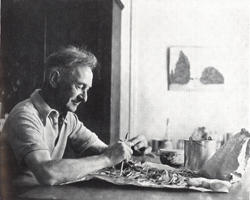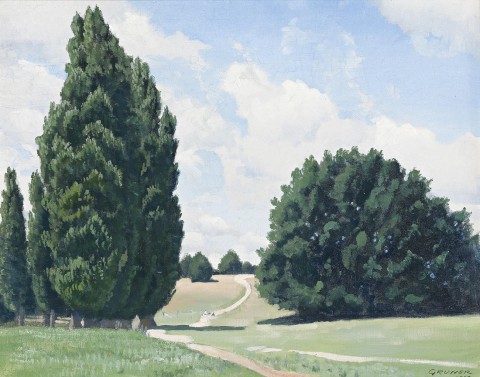THE PATH TO THE TOWN, CANBERRA, 1937
ELIOTH GRUNER
oil on canvas
41.0 x 51.0 cm
signed and dated lower right: GRUNER / 1937
bears inscription verso: PATH TO THE TOWN, CANBERRA
Mr W.G. Buckle, Sydney
Private collection, Sydney
Christie’s, Melbourne, 27 April 1999, lot 10
Private collection, Melbourne
Australian Academy of Art: First Exhibition, Education Department’s Gallery, Sydney, 8 – 29 April 1938, cat. 88 (as ‘Path to the Town, Canberra’) (lent by Mr W.G. Buckle)
Elioth Gruner Memorial Loan Exhibition, National Art Gallery of New South Wales, Sydney, 17 April – 31 May 1940, cat. 141 (lent by Mr W.G. Buckle) (label attached verso)
McKinnon, F., ‘Australia’s New Academy Holds Its First Exhibition’, Courier-Mail, Brisbane, 28 May 1938, p. 10
‘First Exhibition of Australian Academy of Art’, Art in Australia, Sydney, 3rd series, no. 71, 16 May 1938, p. 17 (illus.)
‘Art in Australia’, The Examiner, Launceston, 11 June 1938, p. 3
Buckle, W. G., ‘Elioth Gruner’, Art in Australia, Sydney, 3rd series, no. 77, 15 November 1939, p. 35 (illus. with artist)
Morris, M. and Ure Smith, S. (ed.), Australian Landscape, John Sands, Sydney, 1944 (illus., unpaginated, as ‘Canberra Summer’)
The Path to the Town, Canberra, 1937 had a special appeal for Elioth Gruner. It was one of four paintings (two landscapes and two flower subjects) with which he chose to represent himself in the inaugural exhibition of the Australian Academy of Art shown in Sydney in April 1938. And it was his single work selected for illustration in the May 1938 issue of Art in Australia devoted to the Academy show.1 The following extract from the accompanying article gives insight into how enthusiastically his works were seen by his contemporaries:
The two landscapes are characteristic. There is the first appeal of the general pattern and colour harmony. Nothing of the “snapshot” is seen in his work, though he catches the mood of the moment. Throughout there is evidence of mature consideration, a quiet thoughtfulness that searches into the spirit of his subject. Surface appearances are used to express the feelings which have been stirred by them, and are painted with great refinement. There is always something in reserve.2
Gruner_THE PATH TO THE TOWN CANBERRA.jpg

The popularity of The Path to the Town, Canberra, however, had already been confirmed by its purchase. Its owner for many years was William Buckle (1894 – 1947), noted Sydney amateur photographer, art collector and long time friend of the artist.3 A number of Buckle’s photographs of Gruner working en plein air during a painting trip to Canberra in 1937 were included in a memorial article Buckle wrote for Art in Australia in late 1939.4 The one of A Domestic Scene in Camp shows The Path to the Town, Canberra hanging in the background. Buckle’s collection of Australian art included works by Tom Roberts, Hans Heysen and numerous paintings by Gruner, including After the Rain, 1917, Dream Morning, 1923 and Bellingen Pastoral, 1937. In 1940 the Felton Bequest purchased the latter work from Buckle for presentation to the National Gallery of Victoria.
Gruner’s mastery as a painter of the Australian landscape was readily recognised in his own day, being awarded the Wynne Prize seven times, the last in 1937 with the painting Weetangera, Canberra, (Art Gallery of New South Wales, Sydney). It also won the Society of Artists Award for that same year. Gruner was at his peak. Fellow artist Robert Campbell later wrote:
‘The pictures done around 1937 are quite perfect. The Bellingen series have luminosity, sparkling colour, and, at the same time, carefully considered composition and delicately rendered form. They must always take their place among the fine things of Australian landscape painting’.5
In The Path to the Town, Canberra, Gruner turned his eye from the broad sweep of the panoramic Australian countryside to a closer, more settled view, characteristically intimate in feeling. The silhouetted pattern of trees and winding pathways adds to the flatness of the picture plane, creating a strong sense of design, the path inviting the eye to travel up the rise expectantly towards Canberra beyond. The subtle and sophisticated play between lyricism and the sensuous makes this a painting for the connoisseur.
1. ‘First Exhibition of Australian Academy of Art’, Art in Australia, Sydney, third series, no. 71, 16 May 1938, p. 17, being one of only seven colour plates of works by different artists.
2. ibid, p. 22
3. William Buckle is represented in the photographic collection of the Art Gallery of New South Wales. Obituary, Sydney Morning Herald, 10 March 1947, p. 5
4. Buckle, W., ‘Elioth Gruner’, Art in Australia, Sydney, third series, no. 77, 15 November 1939, pp. 34 – 5
5. Campbell, R., ‘The Art of Gruner’, Art in Australia, Sydney, third series, no. 79, 23 May 1940. p. 32
DAVID THOMAS
